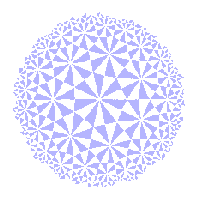
 |
The Klein View of Geometry |
|
In euclidean, similarity and projective geometry, two points are sufficient to determine a line. In inversive geometry, there are infinitely many i-lines through two given points. If A, B ε E, there is one extended line through A and B, but an infinite family of circles.
Here, we show that it needs three points of E+ to determine an i-line. We shall
also The key is
|
|
|
The Fundamental Theorem of Inversive Geometry
If L = (α,β,γ) and L' = (α',β',γ') are lists of distinct points of E+, Note that the element t lies in the subgroup I+(2). There are several ways to prove this result. We offer a constructive proof, based on
The (0,1,∞) Theorem
If L = (α,β,γ) is a list of distinct points of E+, Proof of the fundamental theorem
|
|
|
The (0,1,∞) Theorem allows us to prove the promised results about i-lines. We begin with a special case:
The points 0, 1 and ∞ lie on R, the extended real axis. Since any
i-line through ∞
|
|
|
Theorem I3 (1) If α, β, γ are distinct points of E+, then there is a unique i-line through these points. (2) If L and M are i-lines, then there is an inversive transformation t mapping L to M.
Proof If we ignore the point ∞ we get an unusual proof of a standard euclidean result:
Euclidean Theorem
Proof
|
| Main Inversive Page | Main Klein Page | My Home Page |